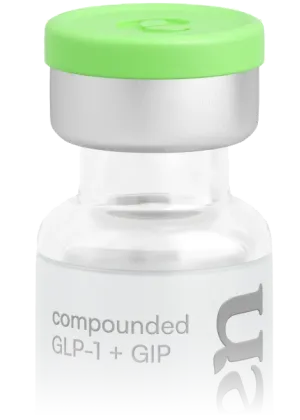Tirzepatide Side Effects: Short- and Long-Term Safety Explained
Learn about tirzepatide side effects, from common short-term issues to rare long-term risks. Find out what to expect and when to talk to a provider.
- What are some of the tirzepatide medication side effects? Gastrointestinal (GI) issues are the most frequent side effects. In clinical studies, rates ranged from 39% to 49%, depending on the dose. The study used tirzepatide medication formulations that were later approved as Zepbound®.
- Nausea was most common, affecting ~13-24% of participants. Diarrhea occurred in 13-21% of participants.
- Timing: Side effects generally appear during dose increases and may improve with continued treatment. Not all patients experience resolution.
- Severity: Most side effects were mild to moderate. Discontinuation rates were 4–7%, depending on the dose, compared with 2.6% for the placebo.
- Rare but serious adverse events included pancreatitis (<0.5%), gallbladder disease, and hypoglycemia (particularly when combined with insulin or sulfonylureas).
- Other side effects reported: constipation, vomiting, injection site reactions, fatigue, and allergic reactions.
Obesity rates continue to rise worldwide. Projections show that by 2035, about 2 billion people, nearly a quarter of the world’s population, will be living with obesity. Medications containing tirzepatide have emerged as important medications for type 2 diabetes under the brand name Mounjaro® and, more recently, as an FDA-approved option for chronic weight management under the brand name Zepbound® in certain adults.
Clinical studies of FDA-approved medications containing tirzepatide (Zepbound® and Mounjaro®) have shown meaningful improvements in body weight and metabolic markers. However, like all medications, tirzepatide carries potential risks and side effects that patients and providers must carefully weigh.
This article provides an educational overview of the most commonly reported side effects from published clinical trials. It is not medical advice. Always consult a licensed healthcare provider before starting, changing, or stopping any prescription medication.
Short-Term Tirzepatide Side Effects
The most common side effects of tirzepatide involve the digestive system. Clinical studies show gastrointestinal issues affected between 39% and 49% of patients, depending on dose. These symptoms generally appear in the first few weeks, often during dose escalation, and then may improve as the body adjusts. Not all patients experience resolution.
Key GI Side Effects (dose-dependent):
- Nausea: 13–24%
- Diarrhea: 13–21%
- Vomiting: 6–14%
- Reduced appetite: ~10%
- Constipation: 2–9%
Providers may start patients at lower doses and gradually increase, which may help minimize these issues.
Long-Term Safety
Long-term studies, including the SURMOUNT and SURPASS programs, suggest that tirzepatide’s safety profile remains consistent over extended use. Both trials used tirzepatide medication formulations that were later approved as Zepbound®. Most side effects remain gastrointestinal and mild to moderate. Discontinuation rates ranged from 4–7% depending on dose, compared with 2.6% for placebo.
Long-term safety findings include:
- Gallbladder disease occurred more often with tirzepatide than with placebo.
- Increases in pancreatic enzymes were observed, though pancreatitis remained rare (<0.5%).
- Blood pressure decreased by ~4–6 mmHg.
- Total cholesterol and triglycerides improved, while HDL increased.
- More than 90% of participants with prediabetes returned to normal blood sugar after 72 weeks.
Weight Regain After Stopping
Evidence suggests that discontinuing tirzepatide may lead to weight regain within about 12 months after stopping. In extension studies, participants who stopped treatment regained much of the lost weight, while those who continued tirzepatide lost additional weight. The formulation used in the referenced study was later approved as Zepbound®. This pattern is consistent with other GLP-1 medications. Many experts now view ongoing therapy as necessary for sustained benefits, similar to long-term treatment for blood pressure or diabetes.
What studies show after stopping tirzepatide:
- Significant weight regain within 1–2 years.
- Return of blood pressure, cholesterol, and diabetes risk toward baseline.
- Risk of regaining nearly all lost weight if therapy is discontinued.
{{primary-cta}}
Rare but Serious Risks
Most side effects are manageable, but some complications require immediate medical attention.
Serious risks include (appearing on both Zepbound® and Mounjaro® FDA labels):
- Pancreatitis: sudden, severe abdominal pain (may radiate to the back).
- Gallbladder disease: abdominal pain, jaundice, fever, pale stools.
- Severe allergic reactions: difficulty breathing, swelling of the face or throat.
- Hypoglycemia: dizziness, sweating, confusion, rapid heartbeat (especially when combined with insulin or sulfonylureas).
- Thyroid C-cell tumors: observed in animal studies; relevance to humans is uncertain. Tirzepatide should not be used in patients with a history of medullary thyroid carcinoma or MEN2.
Comparison With Other GLP-1 Medications
Tirzepatide differs from other GLP-1 receptor agonists because it also activates GIP receptors. Clinical trials comparing tirzepatide to semaglutide show both drugs cause gastrointestinal side effects, though rates and severity vary. Patients without diabetes generally experienced more side effects than those with type 2 diabetes.
Conclusion
Tirzepatide, found in Mounjaro® and Zepbound® is a well-studied medication with a safety profile that is largely consistent with other GLP-1 receptor agonists. The majority of side effects are mild to moderate, most often involving the digestive system. Rare but serious risks, such as gallbladder disease and pancreatitis, require vigilance. Weight regain is common after stopping treatment, which suggests that long-term use may be necessary for sustained results.
Patients should work closely with their healthcare providers to weigh the risks and benefits of therapy, monitor for potential complications, and decide if tirzepatide is appropriate for their health goals.
Zepbound® and Mounjaro® are registered trademarks of Eli Lilly and Company. We do not claim affiliation with or endorsement by Eli Lilly. Eden coordinates care; licensed providers evaluate and prescribe, and partner pharmacies dispense and label medications.
Disclaimer: The FDA does not approve compounded medications for safety, quality, or manufacturing. Prescriptions and a medical evaluation are required for certain products. The information provided on this blog is for general informational purposes only. It is not intended as a substitute for professional advice from a qualified healthcare professional and should not be relied upon as personal health advice. The information contained in this blog is not meant to diagnose, treat, cure, or prevent any disease. Readers are advised to consult with a qualified healthcare professional for any medical concerns, including side effects. Use of this blog's information is at your own risk. The blog owner is not responsible for any adverse effects or consequences resulting from the use of any suggestions or information provided in this blog.
Eden is not a medical provider. Eden connects individuals with independent licensed healthcare providers who independently evaluate each patient to determine whether a prescription treatment program is appropriate. All prescriptions are written at the sole discretion of the licensed provider. Medications are filled by state-licensed pharmacies. Please consult a licensed healthcare provider before making any medical decisions.
Frequently asked questions
Blog Components



References
American Diabetes Association. (2024). Standards of care in diabetes—2024. Diabetes Care, 47(Supplement_1), S1–S187. https://doi.org/10.2337/dc24-SINT
Aronne, L. J., et al. (2024). Continued treatment with tirzepatide for maintenance of weight reduction in adults with obesity (SURMOUNT-4). JAMA. https://pmc.ncbi.nlm.nih.gov/articles/PMC10714284/
Centers for Disease Control and Prevention. (2023). Adult obesity facts. U.S. Department of Health & Human Services. https://www.cdc.gov/obesity/adult-obesity-facts/
Dandona, P., Dhindsa, S., Ghanim, H., & Saad, F. (2020). Mechanisms underlying the metabolic actions of testosterone in humans: A narrative review. Diabetes, Obesity and Metabolism, 23(1), 18–28. https://doi.org/10.1111/dom.14206
Del Prato, S., Kahn, S. E., Pavo, I., Weerakkody, G. J., Yang, Z., Doupis, J., Ahn, C. W., Mody, R., van der Aart-van der Beek, A., Broedl, U. C., & Frias, J. P. (2021). Tirzepatide versus insulin glargine in type 2 diabetes and increased cardiovascular risk (SURPASS-4). New England Journal of Medicine, 385(6), 503–515. https://doi.org/10.1056/NEJMoa2107519
Eli Lilly and Company. (2022). Mounjaro (tirzepatide) injection, for subcutaneous use prescribing information. U.S. Food and Drug Administration. https://www.accessdata.fda.gov/drugsatfda_docs/label/2022/215866s000lbl.pdf
Eli Lilly and Company. (2023). Zepbound (tirzepatide) injection, for subcutaneous use prescribing information. U.S. Food and Drug Administration. https://www.accessdata.fda.gov/drugsatfda_docs/label/2023/217806s000lbl.pdf
Frias, J. P., Davies, M. J., Rosenstock, J., Pérez Manghi, F. C., Fernández Landó, L., Bergman, B. K., Liu, B., Cui, X., & Brown, K. (2021). Tirzepatide versus semaglutide once weekly in patients with type 2 diabetes (SURPASS-2). The Lancet, 398(10295), 143–155. https://doi.org/10.1016/S0140-6736(21)01324-6
Jastreboff, A. M., Aronne, L. J., Ahmad, N. N., Wharton, S., Connery, L., Alves, B., Kiyosue, A., Zhang, S., Liu, B., Bunck, M. C., Stefanski, A., & Wadden, T. A. (2022). Tirzepatide once weekly for the treatment of obesity (SURMOUNT-1). New England Journal of Medicine, 387(3), 205–216. https://doi.org/10.1056/NEJMoa2206038
Ludvik, B., Giorgino, F., Jodar, E., Frias, J. P., Fernández Lando, L., Brown, K., Bray, R., & Rosenstock, J. (2023). Long-term safety and efficacy of tirzepatide in patients with obesity: Results from the SURMOUNT clinical program. The Lancet Diabetes & Endocrinology, 11(3), 210–222. https://doi.org/10.1016/S2213-8587(23)00003-1
National Library of Medicine. (2025, August 15). Tirzepatide injection. MedlinePlus. https://medlineplus.gov/druginfo/meds/a622044.html
Rubino, D. M., Greenway, F. L., Khalid, U., O’Neil, P. M., Rosenstock, J., Sørrig, R., Wadden, T. A., & Wilding, J. P. H. (2022). Effect of continued weekly subcutaneous semaglutide vs placebo on weight loss maintenance in adults with overweight or obesity: The STEP 1 trial extension. Diabetes, Obesity and Metabolism, 24(8), 1553–1564. https://doi.org/10.1111/dom.14725
Wilding, J. P. H., Batterham, R. L., Davies, M., Van Gaal, L. F., Kandler, K., Konakli, K., Lingvay, I., McGowan, B. M., Oral, T. K., Rosenstock, J., Wadden, T. A., Wharton, S., Yokote, K., & Kushner, R. F. (2022). Weight regain and cardiometabolic effects after withdrawal of semaglutide: The STEP 1 trial extension. Diabetes Obesity and Metabolism, 24(8), 1553–1564. https://doi.org/10.1111/dom.14725
World Obesity Federation. (2023). World obesity atlas 2023. https://www.worldobesity.org/resources/resource-library/world-obesity-atlas-2023
Thank you!
We'll be in touch.
Thank you!


















.webp)


